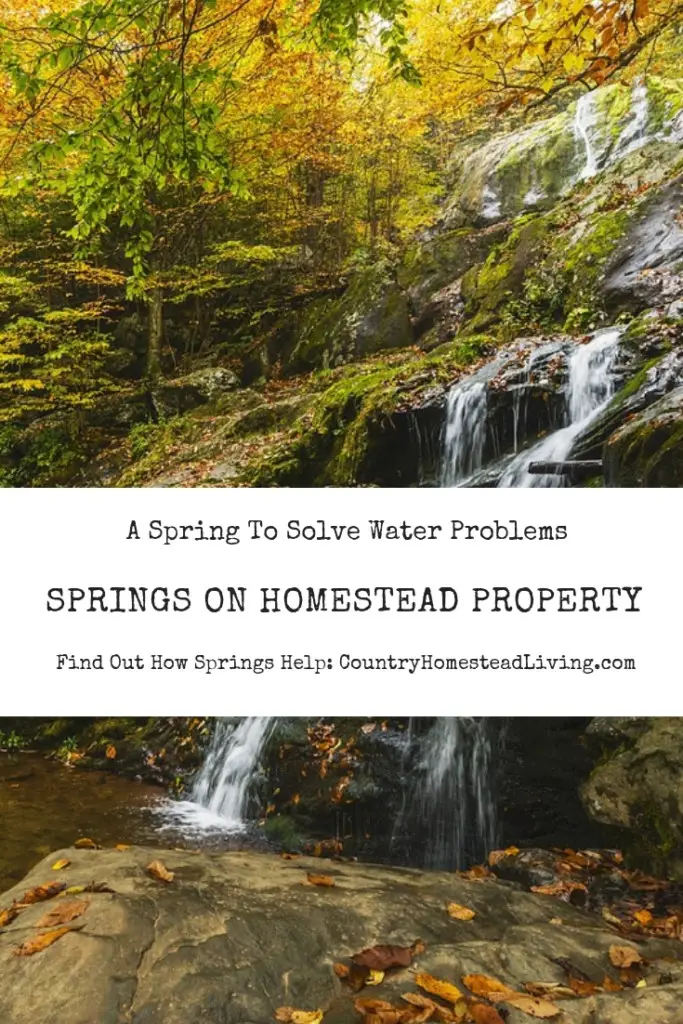As a homesteader I know that water problems on a homestead can affect the quality of homestead life.
The bigger the water problems the more of a detrimental affect those water problems will have on the quality of homestead life.
Can using a spring help solve water problems on a homestead?
Yes, if there is a spring on the homestead property you will need to measure the springs flow, know if the water is pure and be sure you have water rights to the spring.
Knowing how to use it can make a big difference in improving the water problems on a homestead.
So lets take a look at the uses of springs on homestead property.
What Is A Spring?
Springs are areas that are usually on a hillside where water seeps or flows out of the ground.
Two common reasons for the water seeping or flowing out of the ground are cracks in a rock formation that the water flows through.
Or where the building of a road cuts through a water vein.
Springs come in various sizes.
From just an area that is always wet to a stream of water rushing out of a hillside that can be heard long before it is seen.
A common belief is that springs are usually found on the north side of a hill.
But they can also be found on any side of a hill and at any point on the hillside.
Locating A Spring
The most common method of locating a spring is to walk over the property.
Looking for streams of water coming out of the ground.
Or for wet spots that do not dry up.
Springs are most often found on hillsides or at the base of a hill.
However, just because a neighboring property has a spring on it is no indication that the property you are looking at will have a spring.
Water can flow out of one side of a mountain.
And not flow out of the other side!
You may be able to obtain maps of the area that indicate the locations of springs and ground water sources.
Check with a Country Agricultural Extension Agent, Farm Advisor, the US Geological Service in the United States or a similar agency in another country.
In some portions of America the Army Corps of Engineers may have information of water studies done locally.
Measuring A Spring’s Output Or Flow
The most dependable measurements of a spring’s output are those measurements done during the driest season of the year.
When this is done you have a better idea of what help using the spring can give your homestead.
Even a spring that is just a trickle of water can be valuable in helping solve water problems on a homestead.
A trickle that amounts to a gallon of water a minute produces 1,440 gallons of water each day.
Collect this water in a holding tank and you would have enough to support a small homestead.
You can find out how much water is needed in this article I wrote, “Daily Homestead Water Needs (Determining Amounts Necessary).”
A simple method of measuring a springs output is to use a gallon jar and a watch with a second hand.
Collect the water that comes out of the spring in exactly one minute.
And multiply this amount by 60 to get the springs flow per hour.
Multiply the flow per hour rate by 24 to get the well’s output per day.
Even a very small spring that may appear as just a constant wet spot can yield a surprising amount of water.
If the spring’s flow is only 8 ounces per minute that translates to a flow of 90 gallons per day, 630 gallons per week, 2,700 gallons per month and 32,850 gallons per year.
It is possible to improve the springs flow rate by properly opening up the spring.
This process is also called Developing the Spring.
And must be done carefully to prevent the spring from disappearing into the ground.
A properly developed spring can supply water to your homestead for years.
Uses Of A Spring
In the 1800’s and early 1900’s many country places had a Spring House.
A structure built around the spring where the water was used to keep milk, eggs, butter and other foods cool and preserved by placing their container in the spring water.
The Spring House was constructed so the water would form a pool.
And then flow out of the Spring House through an opening on a lower section of the structure and be available for other uses.
On modern homesteads spring water is used to water gardens and orchards as well as live stock.
Spring water may also be used to flush toilets, clean vehicles and other homestead equipment and for human consumption.
If used for human consumption the spring water is tested and treated if need be to remove contaminants.
An excellent method of filtering contaminants out of spring water used for human consumption is to filter the water through a Big Berkey water filter made by British Berkefeld.
This filter is used by British Special Forces the world over as a method of securing safe drinking water.
Is Spring Water Always Pure?
The prevailing belief is that spring water is pure because it has somehow been filtered by the ground.
Sadly, this belief and the reality of the water in many springs are two different situations.
I know of a spring located in a remote area of Montana where people would believe the water flowing out of it to be pure.
Yet laboratory testing of it’s water reveals “bacteria too numerous to count.”
The purity of spring water depends upon several factors.
Including the source of the spring,.
What the water flows through before coming out of the ground.
And even the history of the land upstream, so to speak, from where the spring is found.
The source of the spring could be a scum covered pond that contains dead animal remains and rotting vegetation.
The bottom of the pond could have a crack in an underground rock formation that allows a slow but continual seepage of water from the pond.
If the cracks in the rock formation allow the water to flow to a location where it can exit as a spring without being filtered by sufficient ground material, that spring will not be pure.
The more contaminated the source or the more contaminated the area the water flows through before exiting as a spring the more ground material is needed to filter the water and make it pure.
In areas where it is common to find caves inhabited by bats the water that comes out of the ground as a spring may have flowed through a bat cave a short distance from where the water comes out of the ground.
The cave entrance can be a mile or more away by road from where the water that flowed through it exits the ground.
Yet the water can be flowing through cracks in rock formations.
And not through any ground material that would act as a filter.
A knowledge of what is and has been upstream from the spring can reveal potential problems with contamination of the spring water.
If there has been a history of any mining operations in the area the water from the spring may be contaminated with chemicals used in those mining operations.
Another potential problem is if there was a junk yard or a gas station upstream in the past.
There could be chemicals from the oil and gas that may have leeched into the ground.
And be picked up by the water that later exits as a spring.
Remember, a spring is just an outlet for underground streams of water that are not far from the surface.
And may not have been filtered by flowing through enough ground material.
Depending on what is upstream from where the spring flows out of the ground the larger the springs flow the greater the chance of the spring being contaminated.
Potential contamination such as listed above are reasons to get any spring water tested to see if there are any contaminants present.
If you use the spring it is a good idea to have it tested annually.
Because conditions affecting the stream may change over the course of a year.
If the spring is tested and found to be contaminated talk with someone who works in the field of water treatment about ways to make the spring water safe to use.
The County Health Department or a County Extension Agent can usually give you the name of someone to talk with.
Springs And Water Rights
In the United States if a spring is located on a piece of property and the flow of water does not create a stream that flows off of that land, the land owner of the property with the spring is entitled to the use of all the water flowing from that spring.
If however, the spring creates a stream that flows off the property, the property owners of the land that the stream flows onto may have rights to the use of the water superior to the rights of the land owner of the property containing the spring.
If the spring creates a stream that flows off of the property the best way of knowing what rights to the spring’s water the owner of the property containing the spring has is to check with a Country Attorney in the County where the property is located who practices Real Estate Law.
Using water from a creek or stream flowing across your property or from a pond or lake touching the boundary of your property involves a knowledge of water rights not addressed here.
In most western States, if you use water from these sources and you deprive a prior appropriator of his water you are subject to legal problems.
If there is a creek, stream, pond, or lake on or touching your Country or Homestead Property check with a Country Attorney whose Practice of Law includes Real Estate Law.
He can research and tell you what rights, if any, you have to the water flowing across or touching your property.
I wrote an article titled, “Reservation Of Rights In A Deed, (Timber, Mineral, Water, Etc)” that explains more about water rights.
To Sum It All Up
Using water from a spring, even if it needs to be treated prior to usage, can give you a much more productive homestead.
If your well is less than 10-12 gallons per minute flow a spring can be used to turn a marginal homestead into a good homestead.
Related Questions
What is the difference between a spring and a well?
A spring is formed when water flows out through the ground from a crack in a rock or other natural opening in the ground.
A well is where there has been digging or drilling down through the earth into an underground aquifer to obtain water.
How do you make a spring for drinking water?
You don’t make a spring.
Springs occur when water exits through a crack in rocks or a cut in the ground.
You can develop a spring.
Developing, if done carefully, can increase a springs output and make it easier to collect the water from the spring.
Spring water may need to be filtered to make it safe to drink.
How do I capture spring water?
A common way to capture spring water is to to divert it through a pipe into a large plastic water tank suitable for burying under ground.
In cold climates it should be buried below the frost line.
You would need a way, such as a hand pump, to get the water out of the tank.
You might need an overflow pipe which would allow excess water to flow out of the tank and create a stream of water that your homestead animals could drink from.


